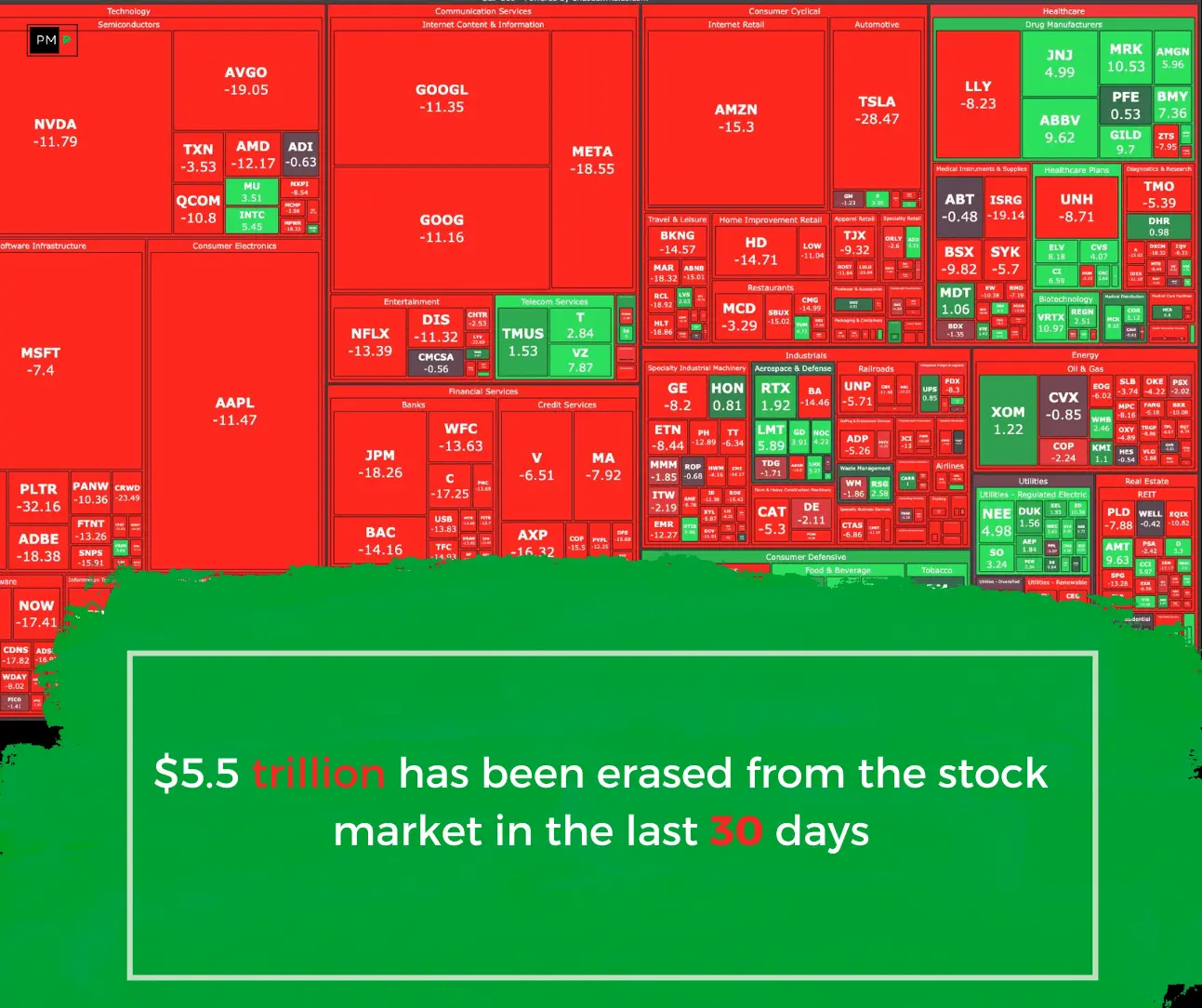1. Market Performance
- $5.5 Trillion Loss: This represents a significant decline in the total market capitalization of U.S. stocks, reflecting widespread sell-offs across sectors.
- Major Indices:
- The S&P 500 (a broad measure of U.S. large-cap stocks) has fallen sharply, potentially entering or nearing bear market territory (a 20% decline from recent highs).
- The Nasdaq Composite (tech-heavy) has been hit particularly hard, as higher interest rates disproportionately affect growth and tech stocks.
- The Dow Jones Industrial Average (blue-chip stocks) has also seen declines, though it may be somewhat more resilient due to its composition of established companies.
2. Key Drivers of the Sell-Off
- Rising Interest Rates: The Federal Reserve has been aggressively raising interest rates to combat inflation. Higher rates increase borrowing costs for companies and reduce the present value of future earnings, which weighs heavily on stock valuations, especially for growth and tech stocks.
- Inflation Concerns: Persistent inflation, particularly in areas like energy, food, and housing, has eroded consumer purchasing power and corporate profit margins. This has led to fears of a potential economic slowdown or stagflation (high inflation combined with stagnant growth).
- Geopolitical Risks: Ongoing tensions, such as the war in Ukraine, U.S.-China relations, and energy supply disruptions, have added to market uncertainty.
- Earnings Concerns: Many companies are warning of slowing revenue growth and rising costs, which could lead to weaker-than-expected earnings in upcoming quarters.
- Recession Fears: Investors are increasingly worried that the Fed’s aggressive rate hikes could push the U.S. economy into a recession, leading to reduced consumer spending and business investment.
3. Sector Performance
- Technology and Growth Stocks: These sectors have been hit hardest due to their sensitivity to interest rates. Companies like Apple, Amazon, Microsoft, and Tesla have seen significant declines.
- Energy: While energy stocks had been a bright spot earlier in the year due to high oil and gas prices, they have also faced pressure recently as concerns about a global economic slowdown weigh on demand expectations.
- Consumer Discretionary: Companies in this sector, which rely on consumer spending, are under pressure as inflation erodes disposable income.
- Defensive Sectors: Utilities, healthcare, and consumer staples have held up relatively better as investors seek safer, more stable investments.
4. Investor Sentiment
- Fear and Uncertainty: The CBOE Volatility Index (VIX), often referred to as the “fear gauge,” has spiked, indicating heightened market anxiety.
- Shift to Safe Havens: Investors are moving toward safer assets like U.S. Treasuries, gold, and cash, leading to higher bond prices and lower yields.
- Retail Investor Pullback: Retail investors, who had been active in the market during the pandemic, are pulling back as losses mount.
5. Global Context
- The U.S. market decline is part of a broader global trend, with European and Asian markets also experiencing significant losses. Central banks worldwide are tightening monetary policy to combat inflation, which is contributing to a synchronized global slowdown.
6. What’s Next?
- Fed Policy: The Federal Reserve’s next moves will be critical. If inflation shows signs of easing, the Fed may slow its rate hikes, which could stabilize markets. However, if inflation remains stubbornly high, further aggressive tightening could exacerbate the sell-off.
- Economic Data: Key indicators like employment reports, GDP growth, and consumer spending will be closely watched for signs of a recession.
- Corporate Earnings: Upcoming earnings reports will provide insight into how companies are navigating inflationary pressures and slowing demand.
7. Long-Term Implications
- Market Correction: While painful, this sell-off could be a necessary correction after years of ultra-low interest rates and inflated valuations.
- Opportunities: For long-term investors, the decline may present buying opportunities in high-quality companies at discounted prices.
- Structural Changes: The market may see a shift in leadership, with value and dividend-paying stocks potentially outperforming growth stocks in a higher-rate environment.
In summary, the $5.5 trillion loss reflects a confluence of macroeconomic and geopolitical challenges. While the short-term outlook remains uncertain, the situation underscores the importance of diversification and a long-term perspective in navigating volatile markets.




